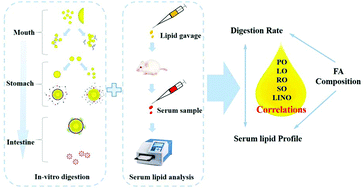Lipid composition modulates the intestine digestion rate and serum lipid status of different edible oils: a combination of in vitro and in vivo studies†
Abstract
The objective of the present study was to investigate the connections between lipid compositions and the digestion and absorption differences of different lipids. Five typical edible oils (palm oil, PO; leaf lard oil, LO; rapeseed oil, RO; sunflower oil, SO; linseed oil, LINO) were selected to conduct in vitro digestion experiments considering the lipid digestion extent and hydrolysis rate before analyzing the fatty acid composition and TAG profiles using GC and UHPLC-Q-TOF-MS/MS. Meanwhile, the postprandial lipid absorption status after gavage administration was examined in adult male Sprague-Dawley rats with respect to serum lipid profiles. The results showed that the maximum FFA release extent decreased in the order: PO > RO > LINO > SO > LO, and the FFA release apparent constants were PO > SO ≈ RO > LO ≈ LINO. This suggested that the fatty acid species and the location of fatty acids within TAG molecules could significantly affect the lipid digestion fates in the gastrointestinal tract, and short chain saturated fatty acids located at the Sn-1, 3 position could favor the lipid digestion process. PO and LO were both shown to be more likely to affect the serum TG levels and LDL-C : HDL-C ratio compared with RO, SO and LINO. Different fatty acids displayed different correlations with serum lipid profiles when examined by Pearson correlation analysis. This suggested that fatty acid composition and TAG profiles may influence first the digestion rate and then the serum lipid profiles. This further confirmed that lipid composition could modulate the digestion and absorption status under the gastrointestinal conditions. These findings may provide some basic understanding of the connections between lipid composition and their functional difference.



 Please wait while we load your content...
Please wait while we load your content...